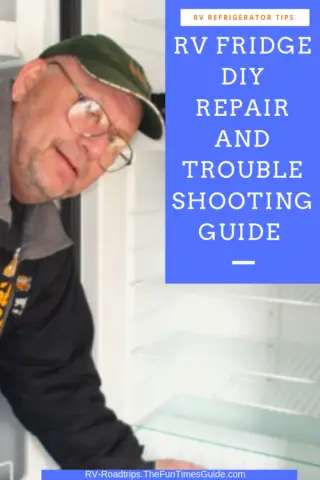I’ve got some helpful RV refrigerator repair tips for you — whether you have a Dometic refrigerator not cooling, a Norcold refrigerator not cooling, or any other RV fridge not working properly.
Most RV owners have little understanding about how the refrigerator works — beyond turning it on and switching between gas and electric operation.
When the beer feels warm and the butter is melted, then it’s time fill the cooler with ice and make a last ditch effort to save the food.
The one thing you need to know is that your RV refrigerator operates completely different from your home refrigerator:
- There is no compressor pumping freon through coils. Instead, heat from either an electric element or a small flame causes a percolating action that circulates an ammonia mixture through cooling tubes. In many ways, this is a simpler (easier to troubleshoot) method of cooling with its own built-in backup system.
- Most RV refrigerators operate on either 110v AC or propane gas. Some also operate on 12v DC, as well.
If you’ve come here to find help with your RV refrigerator not cooling or your RV fridge not working at all, then the following steps will help you localize the problem, and (hopefully) get you back up and running at little or no expense.
How To Diagnose RV Refrigerator Repair Problems Yourself
#1 – First, use your nose.
If the cooling unit is punctured, you will smell a strong ammonia odor.
If you do smell ammonia, your situation is dire.
Most likely, the cost of repair will make replacing the refrigerator a more practical solution than repairing it.
An RV dealer can determine which option would be the most cost-effective in your case.
Must Read: 10 RV Odors – What They Mean & How To Remove Them
#2 – Test all modes of operation.
If the RV refrigerator works on gas but not on electric — or on electric but not gas — there are some things you can do to narrow down the possibilities of what’s causing this.
If your RV fridge works on gas but not on 110v AC, then try this:
- The first step is to verify you have 110v AC at the refrigerator. Check circuit breakers and fuses, but most importantly you need to check the outlet at the back of the refrigerator to make sure voltage really is there. Using a multimeter is the best choice, but plugging something like a lamp or a blow dryer into the outlet will also verify that voltage is present. Verify that there is 12v DC at the refrigerator because it uses both levels of electricity to work.
- If voltage is present and all indicator lights seem to operate, the next item to test is the electric heating element. When testing an electric heating element a multimeter is the proper tool for this. Just be careful because you are dealing with dangerous voltages. The wires leading to the heating element come down from the tin enclosure where it rests along the cooling unit. In most instances, you can access the wires with only minor removal of shielding. Test for voltage while the element is hooked up. If you have voltage at one wire but not the second, most likely the element is burned out creating a break in the voltage path.
- If you have no voltage at the element, your problem may lie in the circuit boards of the refrigerator. This is the time to take it to a qualified RV dealership and have the problem looked at by professionals.
If your RV fridge works on 110v AC but not on propane, then try this:
- Determine if you have a good quality flame. If the flame lights but goes out almost immediately, the thermocouple (which acknowledges the presence of a flame) may have failed. This device is attached to the main gas valve at the back of the refrigerator and has a tube extending to the vicinity of the gas burner. In most instances, this can be replaced by an owner with some mechanical ability.
- If the flame stays lit, the next issue is the quality of the flame. Often rust and debris will fall from the vent interfering with the burner system. I personally have experienced this problem twice, causing the burner not to light at all. To fix the problem only requires removing a minimal amount of tin shielding and then vacuuming the area around the burner thoroughly.
- If the flame fails to light, vacuuming the burner area may clear the port (or jet) of the burner. Worst case scenario… run a very thin wire into the burner orifice to clear debris. Because a small steady flame may not be the proper flame, I recommend cleaning the area with a vacuum in every case of failure.
This video shows you how to clean the burner area of a typical RV refrigerator:
Worth Mentioning…
3-way refrigerators that will also operate solely on 12v DC have an extra electric heating element. Confirming voltage at the heating element is done in the same way as testing the 110v AC mode of operation (mentioned above).
Often, it’s the small things that will take an RV refrigerator offline.
By checking these simpler items, you may be able to avoid a hefty RV refrigerator repair bill. At the very least, you can give the technician a better description what’s working and what isn’t.
Must Read: RV Refrigerator Repair vs Replacement Guide
Like this post? Save it to read again later… or share with others on Pinterest!




